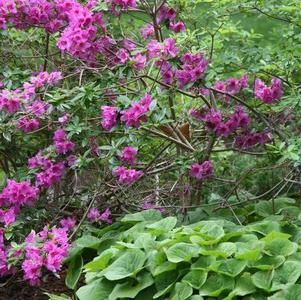General Description
Bloom Description: Ferns do not produce flowers, instead reproducing by spores. The fronds are slow to appear in spring, usually arising in late May. The young pinnae (leaflets) have a reddish color as they begin to emerge.
Growth Habit & Shape: This is a shorter fern that forms a dense clump. The fronds have their leaves all at the top of the rachis (stem), and the pinnae (leaflets) unfurl to create a flat, fan shape. The color and the form is very distinctive and a welcome addition to many gardens.
Soil Preferences: Maidenhair fern naturally occurs in reasonably alkaline soil, but in the garden it is tolerant to a wide range of soil types and moisture conditions. It will grow in average garden soil to rich, limey forest soils. It is easy to get established, forming a stout clump within two to three years. It can grow in dryer soils than many ferns, but also seems to thrive where the soils may be seasonally wet.
Root Description: The roots are a slow, short-creeping rhizome, with new fronds arising from the root in tight clusters.
Garden Uses: Adiantum pedatum has many uses in the garden. its distinctive growth habit makes it an excellent specimen. The short stature of the plant and unique growth pattern also makes it perfect for massing. It is slow to expand, as the diameter of the clump increases on an annual basis.
Best Management & Maintenance: Maidenhair fern is very easy to care for. The foliage will burn when exposed to full fun in summer, but will tolerate full morning sun throughout the year. We like to cut it back in fall, since the wiry stems do not die back quickly enough to be obscured by new growth in spring.
Common Problems: none
Benefits
Ornamental Value: The spring foliage emerges with a reddish hue in early May. The fronds are persistent into November, but not through the winter. The black rachis (stem) is a nice contrast to smaller white flowers and an outstanding feature of this plant.
Wildlife Benefits: cover for small mammals and amphibians.
Other Practical/Environmental Benefits: Ferns tend to grow with their rhizomes close to the surface of the soil. In some instances this can provide erosion control. This fern does not spread quickly so the effect would be minimal.
Use in place of: Bearded Iris
Ecology
Habitat:
Rich, deciduous woodlands, often on humus-covered talus slopes and moist lime soils
Ecosystems:
This species is listed in the following United States National Vegetation Classification macrogroups:
-M008 Fagus grandifolia - Magnolia grandiflora - Quercus alba Forest Macrogroup
-M013 Robinia pseudoacacia - Liriodendron tulipifera - Acer platanoides Ruderal Forest Macrogroup
-M014 Acer saccharum - Betula alleghaniensis - Tsuga canadensis Forest Macrogroup
-M016 Quercus alba - Quercus falcata - Pinus echinata Forest & Woodland Macrogroup
-M024 Tsuga heterophylla - Picea sitchensis - Sequoia sempervirens Rainforest Macrogroup
-M034 Picea engelmannii - Populus angustifolia / Cornus sericea Riparian & Swamp Forest Macrogroup
-M035 Vancouverian Flooded & Swamp Forest Macrogroup
-M061 Dasiphora fruticosa - Sanguisorba canadensis / Carex interior Seep Macrogroup
-M076 Warm Desert Lowland Freshwater Marsh, Wet Meadow & Shrubland Macrogroup
-M111 Eastern North American Cliff & Rock Vegetation Macrogroup
-M500 Tsuga heterophylla - Abies grandis - Larix occidentalis Lower Montane Forest Macrogroup
-M502 Appalachian-Northeastern Oak - Hardwood - Pine Forest & Woodland Macrogroup
-M882 Central Midwest Mesic Forest Macrogroup
-M883 Appalachian-Interior-Northeastern Mesic Forest Macrogroup
-M887 Pseudotsuga menziesii - Pinus ponderosa / Moss Western North American Cliff, Scree & Rock Vegetation Macrogroup
Response to Disturbance: Ferns tend to grow with their roots close to the surface, and rhizomes (either creeping or upright) are easily damaged. Damaging or breaking the tips of rhizomes, typically above or just below the surface of the ground, can prevent leaf-out and photosynthesis. As such, these structures should be protected and planted out of the way of foot or dog traffic. Likewise, since ferns are slow to establish, soil near or around the base of the plant should be left undisturbed as much as possible. Divisions and transplants can be done early in spring prior to the fiddleheads' emergence.
Native State Distributions:
Canada: NB, NS, ON, QC
USA: AL, AR, AZ, CT, DC, DE, GA, IA, IL, IN, KS, KY, LA, MA, MD, ME, MI, MN, MO, MS, NC, NE, NH, NJ, NY, OH, OK, PA, RI, SC, SD, TN, VA, VT, WA, WI, WV
Wetland indicator status: FACU
References
Return to Top
